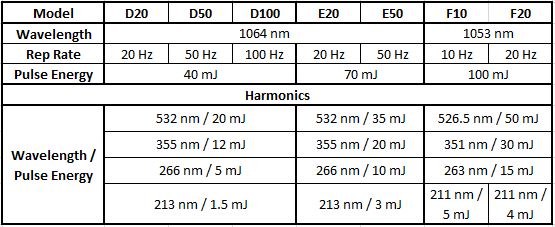
Solid-state lasers offer many advantages over other laser sources. One of their most unique benefits is the ability to produce extremely high pulse energy. Solid-state lasers can achieve this through q-switching, which is a process where the resonator losses are periodically increased, therefore interrupting the lasing process. Unlike other laser pulsing methodologies, q-switching is unique in that the pump source remains active while no lasing is occurring. Constant pumping forces the laser crystal to store the energy from the pump, similar to a capacitor. And just as with a capacitor in an electrical circuit, once you flip the switch and lasing can once again occur, the crystal will “discharge” all of the stored energy as fast as physically possible, resulting in an extremely high-energy laser pulse.
One example is the Quantas-Q2HE, a high energy q-switched diode-pumped solid-state (DPSS) laser series from Quantum Light Instruments. The Q2HE, available at both 1064 nm (Nd:YAG) and 1053 nm (Nd:YLF), can produce pulse energies up to 70 mJ and 100 mJ respectively, with a typical pulse duration of less than 7 ns. Therefore, the 1053 nm version of the Quantas-Q2HE ends up producing a peak power of nearly 17 kW. These extremely high peak powers make the Q2HE laser series an ideal choice for harmonic generation.
We have previously discussed the physics behind harmonic generation. The most important thing to take away from these discussions is that as a general rule of thumb, there are two ways to increase the efficiency of harmonic generation: increasing the peak power and decreasing the spot size. Since the Quantas-Q2HE has a bell-shaped beam profile, with a greater than 75% Gaussian fit on top of the extremely high peak power discussed previously, it is not only useful for second harmonic generation but third, fourth and fifth harmonic generation as well. As a result, the Q2HE can produce wavelengths as low as 211 nm. The Quantas-Q2HE is available in seven different configurations, all of which can generate fifth harmonic light, as shown in the table below.
This air-cooled, q-switched series of lasers provides high-speed triggering pulses with RMS jitter > 0.5 ns (with respect to Q-switch triggering edge of the pulse), and both internal and external triggering, making this laser ideal for a wide range of high-speed applications. Additionally, the Quantas-Q2HE laser series is controlled via a built-in Ethernet port with the option to add Wi-Fi adapter, allowing users to monitor and control the laser remotely. All of these features, combined with its optical characteristics, make the Q2HE the ideal laser source for high energy applications ranging from the near-infrared to the deep ultraviolet, including Laser-Induced Breakdown Spectroscopy (LIBS), LCD repair, laser ablation, remote sensing, and many others.
• Part 2 •
“High-Energy Q-Switched Lasers for Harmonic Generation – Part 2“
If you would like to get more detailed information on the Quantas-Q2HE series of high energy DPSS lasers from Quantum Light Instruments that are offered here at RPMC Lasers, Contact Us here or email us today at [email protected] to let one of our knowledgeable Product Managers assist you.

 SHIPS TODAY
SHIPS TODAY 
